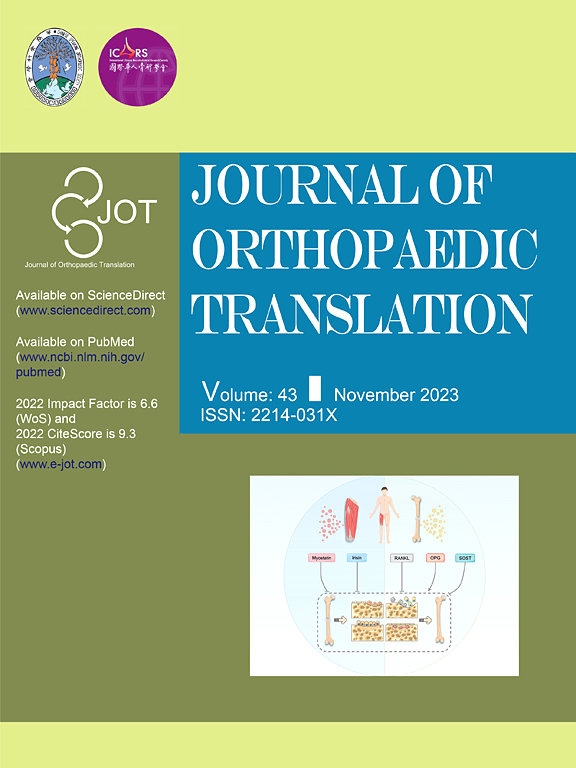Epidemiological profiles and intervention strategies of limb deformities in China: A nationwide study based on the largest orthopedic database in China
IF 5.9
1区 医学
Q1 ORTHOPEDICS
引用次数: 0
Abstract
Background
Limb deformities are almost associated with varying degrees of disability, which severely affects the quality of life and social participation. However, the epidemiological profiles of limb deformities remain underreported. As the world's largest developing country with regional economic disparities, China faces unique challenges in the diagnosis and management of limb deformities. The Qin Sihe Orthopaedic Surgery Database is currently the most comprehensive database of limb deformity in China, which has the largest case volume, the widest disease spectrum, and the broadest geographical coverage, provides an invaluable resource for studying limb deformity patterns in China and other developing countries.
Objective
To analyze 37763 limb deformity cases from the Qin Sihe Orthopaedic Surgery Database, and to summarize the etiology distribution, disease spectrum, gender, age, geographical distribution, gait abnormalities and treatment strategies of limb deformities in China.
Methods
Descriptive epidemiological methods were used to analyze the data of Qin Sihe Orthopaedic Surgery Database from May 25th, 1978 to December 31st, 2023 containing 37763 cases of Limb deformities. The data on patients' gender, age, etiology distribution, disease spectrum, geographical distribution, gait abnormalities and surgical methods etc will be statistically analyzed.
Results
Among 37763 patients, 21815 (57.77 %) were male and 15948 (42.23 %) were female, aged 1–84 years old, covering 33 provinces, municipalities and autonomous regions in China and some international regions. Etiologies included 239 neurogenic, traumatic, congenital and metabolic diseases, among which neurogenic diseases took the dominant portion: 24430 (64. 7 %) cases of post-polio sequelae, 5088 (13. 4 %) cases of cerebral palsy. Lower limb deformities(35,869 cases,95 %) was significantly more than upper limb deformities (646 cases, 1.7 %). The surgical interventions included soft tissue release and tendon lengthening (e. g. Achilles tendon lengthening, 8282 cases, 21.93 %), osteotomy (e.g. supracondylar femoral osteotomy, 7740 cases, 20.50 %), and arthrodesis (e. g. talocalcaneal arthrodesis, 6873 cases, 18.20 %). The fixation methods included Ilizarov external fixation (5611 cases), combined external fixation (5612 cases), combined internal fixation (1805 cases) and plaster or brace immobilization (24735 cases).
Conclusion
The causes of limb deformities in China are diverse, and the diseases involves multiple disciplines. Cases are predominantly male and young., Polio sequelae deformity remains the main malformation diseases, but the proportion of cerebral palsy, limb deformities after trauma, lower limb deformities after spina bifida and genetic metabolic diseases are increasing. This study provides important real-world data for the classification of etiological classification, precise diagnosis and treatment, and public health policy formulation of limb deformities in China.
The translational potential of this article
This study is the most comprehensive big data analysis to date on the causes and treatment of limb deformities in China. The research results have revealed the main epidemiological characteristics of limb deformities in China, which is helpful for formulating more effective disability prevention and control strategies at the clinical diagnosis and public health levels in the future. Based on this data, a big data model for lower limb deformities may be gradually established, and the disease prevention and treatment system for limb deformities can be improved. According to the different types and causes of the diseases, the prevention and treatment level of limb deformities can be enhanced, and the disability rate caused by limb deformities can be reduced. In the future, the application depth of artificial intelligence-assisted diagnosis and interdisciplinary collaboration mechanisms can be further expanded.

中国肢体畸形的流行病学概况和干预策略:基于中国最大的骨科数据库的全国性研究
背景肢体畸形几乎与不同程度的残疾相关,严重影响生活质量和社会参与。然而,肢体畸形的流行病学概况仍然报道不足。作为世界上最大的发展中国家,中国在肢体畸形的诊断和治疗方面面临着独特的挑战。秦思河骨科数据库是目前中国最全面的肢体畸形数据库,病例量最大,疾病范围最广,地理覆盖范围最广,为研究中国和其他发展中国家的肢体畸形模式提供了宝贵的资源。目的分析秦思河骨科数据库中37763例肢体畸形病例,总结中国肢体畸形的病因分布、疾病谱、性别、年龄、地理分布、步态异常及治疗策略。方法采用描述流行病学方法,对1978年5月25日至2023年12月31日秦思河骨科数据库37763例肢体畸形病例进行分析。对患者的性别、年龄、病因分布、疾病谱、地理分布、步态异常、手术方式等数据进行统计分析。结果37763例患者中,男性21815例(57.77%),女性15948例(42.23%),年龄1 ~ 84岁,覆盖全国33个省、市、自治区及部分国际地区。病因包括神经源性、外伤性、先天性和代谢性疾病239种,其中神经源性疾病占主导地位,24430例(64例)。小儿麻痹症后后遗症5088例(7%)。4%)脑瘫病例。下肢畸形35,869例(95%)明显高于上肢畸形646例(1.7%)。手术干预包括软组织松解和肌腱延长术(如跟腱延长术,8282例,21.93%)、截骨术(如股骨髁上截骨术,7740例,20.50%)和关节融合术(如距跟关节融合术,6873例,18.20%)。固定方法包括Ilizarov外固定架(5611例)、联合外固定架(5612例)、联合内固定架(1805例)和石膏或支具固定(24735例)。结论中国肢体畸形病因多样,疾病涉及多学科。病例主要是男性和年轻人。脊髓灰质炎后遗症畸形仍是主要的畸形疾病,但脑瘫、创伤后肢体畸形、脊柱裂后下肢畸形和遗传性代谢性疾病的比例在增加。本研究为中国肢体畸形的病因分类、精准诊疗和公共卫生政策制定提供了重要的现实数据。本研究是目前国内对肢体畸形病因及治疗的最全面的大数据分析。研究结果揭示了中国肢体畸形的主要流行病学特征,有助于今后在临床诊断和公共卫生层面制定更有效的残疾防控策略。基于这些数据,可以逐步建立下肢畸形大数据模型,完善下肢畸形疾病防治体系。根据疾病类型和病因的不同,提高肢体畸形的防治水平,降低肢体畸形致残率。未来,人工智能辅助诊断和跨学科协作机制的应用深度可以进一步拓展。
本文章由计算机程序翻译,如有差异,请以英文原文为准。
求助全文
约1分钟内获得全文
求助全文
来源期刊

Journal of Orthopaedic Translation
Medicine-Orthopedics and Sports Medicine
CiteScore
11.80
自引率
13.60%
发文量
91
审稿时长
29 days
期刊介绍:
The Journal of Orthopaedic Translation (JOT) is the official peer-reviewed, open access journal of the Chinese Speaking Orthopaedic Society (CSOS) and the International Chinese Musculoskeletal Research Society (ICMRS). It is published quarterly, in January, April, July and October, by Elsevier.
 求助内容:
求助内容: 应助结果提醒方式:
应助结果提醒方式:


